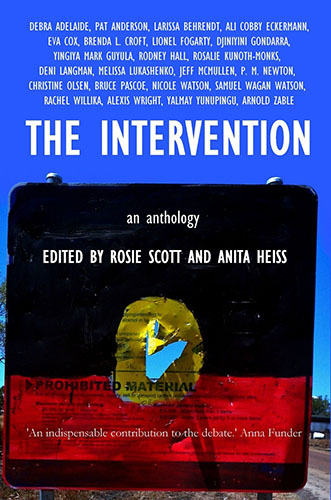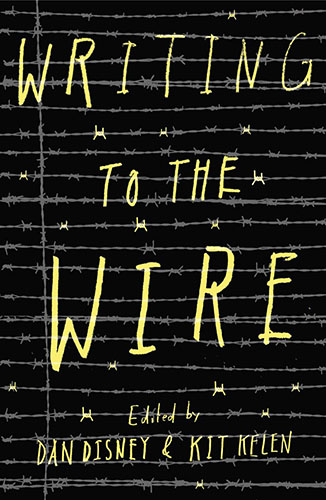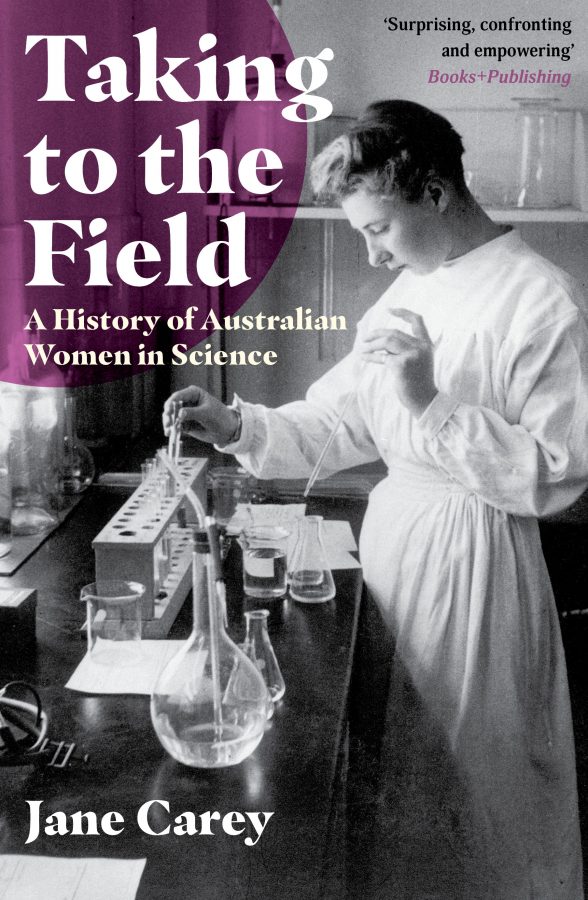Deep Listening: The Intervention Anthology & Writing to the Wire
Australia’s long habit of state-sanctioned racism is most evident in its treatment of its first peoples and its newest arrivals. These two recent anthologies address Australian racism in different ways and with different levels of success. The first, The Intervention Anthology, edited by Anita Heiss and Rosie Scott and recently updated from a 2014 edition, reflects on the experience for Aboriginal people living under the Northern Territory Intervention. The second, Writing to the Wire, is a poetry anthology edited by Dan Disney and Kit Kelen and it offers an examination of Australia’s treatment of refugees.
Two projects of collective authorship, these books interrupt the singular authority that has imposed the Intervention onto Aboriginal communities in the Northern Territory and mandatory immigration detention onto asylum seekers who arrive in Australia by boat. The two books resonate when their contributors reflect on the connections between the experience of Indigenous people and people seeking refuge in Australia. However, they do markedly different work in the service of resisting the human rights abuses particular to each situation. The Intervention Anthology has a strategic purpose: the texts were curated as part of the campaign to repeal the Stronger Futures legislation and to restore self-determination to Aboriginal communities in the Northern Territory. The editors particularly seek to educate young Australians about the costs of such policies as a safeguard for the future. On the other hand, Writing to the Wire expresses a shared lament as poets inside and outside of immigration detention bear witness to its visceral oppression.
In The Intervention Anthology, Scott and Heiss have gathered accounts of life under the Intervention from Aboriginal community members and leaders in the Northern Territory (Rosalie Kunoth-Monks, Rachel Willika, Djiniyini Gondarra, Yingya Mark Guyula, Deni Langman, Yalmay Yunupingu, Mark Yingiya, Helen Nyomba Gandangu, Matthew Dhhulumburrk Gaykamangu, John Leemans). These appear alongside commissioned pieces by Aboriginal and non-Aboriginal writers who provide thoroughgoing analysis of the policy and media landscape in which the Intervention is experienced (Larissa Behrendt, Jeff McMullen, Eva Cox, Nicole Watson, Brenda L. Croft, Rodney Hall), as well as wide-ranging reflections on and interpretations of the implementation, effects, and context of the Intervention (P.M. Newtown, Natalie Harkin, Debra Adelaide, Bruce Pascoe, Ali Cobby Eckermann, Samuel Wagan Watson, Arnold Zable, Alexis Wright).
The collection prioritises Aboriginal voices and in doing so, highlights the routine neglect of Aboriginal testimony in white Australia, in particular in legislative and policy making arenas. Along with providing substantial evidence of the Intervention’s failure to support Aboriginal people in the Northern Territory, the anthology functions as a colloquium of voices against the Intervention (which continues today, under the name Stronger Futures). Taken together, the words of Aboriginal people and their advocates collected here should be difficult for anyone they address to ignore – be they an Australian citizen, white Australian, policy-maker, politician, or social commentator. The initial version of the book was produced through a collective effort in 2014, using crowdfunding and public grants to get into print. NewSouth Books took on publication of this 2016 edition, which includes a new Preface. The new edition also includes teachers’ notes for use in schools, which makes explicit the pedagogical function of the text. Scott and Heiss are experienced editors and this volume shows their understanding of the cultural work an anthology can perform; The Intervention Anthology is of a kind with Walk with Us (2011), a publication of Aboriginal Elders’ perspectives on the Intervention, and This is What We Said (2010), a collection of pictures and quotations taken from the government consultations on the Intervention; both edited and produced by Concerned Australians, a collective dedicated to justice for Indigenous Australia which includes Scott.
In 2007, the Howard government imposed the Northern Territory Intervention – largely in response to claims that Aboriginal communities in the Territory were in the grip of organised paedophile rings, and with the stated intention of arresting high rates of child sexual abuse in Aboriginal communities. The actual effects of the Intervention were devastating and only exacerbated the conditions which give rise to, for example, the current over-representation and abuse of young Indigenous people in prison, and the appallingly high rates of suicide and early and preventable deaths amongst Indigenous people in the Territory. It is this context that The Intervention Anthology addresses the shock of military occupation, the distress of being subject to policies that explicitly seek to control and assimilate, the deep pain of losing land and the humiliation of stigma. In a chapter entitled ‘Reflections on the Intervention’, Arrernte woman Rosalie Kunoth-Monks puts it like this:
We were told to gather at Utopia [Aboriginal Community], the basketball area which is quite a big expanse of open area and all of a sudden we became aware, around us, were public servants, the police, and also – this is my recollection – and also the army. Some of these people were armed, if they weren’t armed they had batons … The shock – you could almost taste it – and our hearts – our hearts were sinking and we didn’t quite know whether we were going to be shot or put into paddy wagons or whatever. And then the directives came like shots from these rifles anyway and we were told there was a new way that Aboriginal affairs is going to be handled. And that was our introduction to the Intervention. And I can tell you that it was horrific.
Later in 2007, the Rudd government was elected, and was repeatedly advised not only that the Intervention was having dire effects on Aboriginal communities but that it constituted multiple breaches of international law. Rudd’s response was the Stronger Futures in the Northern Territory Bill, passed in June 2012. This made some changes to the income quarantining component of the initial Intervention but left much of its architecture in place. Anita Heiss recollects the passage of this Bill:
Following the Senate spending most of the previous day debating legislation aimed at re-introducing the offshore processing of asylum seekers and media covering it extensively, the Upper House continued sitting until early in the morning to pass the Stronger Futures legislation before a parliamentary recess. It was a non-debate, with many senators missing from the house.
Aboriginal people across the Territory affected by the Intervention testified to the Senate Inquiry as to its damaging effects. Their voices are amplified in The Intervention Anthology. Dyiniyini Gondarra describes the impact of increased police powers in these terms:
The Stronger Futures Bills will… continue the powers for police to take people away from our town without telling anyone and to interrogate our citizens without representation. Once again, I consider this racist as it does not apply to any other Australian citizens. It is also a major disrespect to the jurisdiction of the Yolngu nation while at the same time limiting my people’s individual rights.
Yalmay Yunupingu points to the devastating effect on young people and the continuation of Aboriginal culture:
When governments attempt to manipulate and dictate our lives, such as threatening to send all our teenagers away from our communities or telling us that we can’t teach our children how to read and write in their own language, we feel like a knife has gone through our body and the knife keeps going deeper and deeper.
Many of the texts also remind us that there has been rigorous condemnation of the policy from senior global human rights officials, and that the Australian Crime Commission found in 2009 that claims that organised paedophile rings were operating in Aboriginal communities in the Territory were baseless. None of this seemed to matter to Australia’s parliamentarians. With the passage of the Stronger Futures bill into law in 2012, the Intervention was rolled over for a further ten years.
The Stronger Futures legislation was passed at about the same time as the Gillard government convened an expert panel led by Angus Houston to report on the best way to prevent asylum seeker boat arrivals. Noting this coincidence, Anita Heiss points to the parallel fates of Aboriginal people and people who arrive by boat to Australia. Under Commonwealth government policy that has been in place in one form or another since 1992, so called ‘boat people’ face indefinite imprisonment in immigration detention centres, a policy which was again extended to offshore detention locations on Manus Island and Nauru just as the Northern Territory Intervention was extended for a decade. As Heiss observes, there was extensive media attention and political scrutiny on the offshore processing legislation in light of the human rights abuses of mandatory immigration detention (which almost exclusively affects people of colour), whilst those of the Intervention were publicly ignored and few Senators even bothered to turn up for the debate on the legislation that continued it.
Ghassan Hage has referred to the Australian obsession with boat arrivals as ‘the sensitivity of thieves’, thieves who arrived by boat and colonised this land and its people. This analysis is borne out in both The Intervention Anthology and Writing to the Wire. The contributors to the two books recognise that Australian policymakers have been unable to adequately address the theft of the country from Aboriginal people and subsequent acts of genocide and institutional oppression. As such, there is an sensitivity in policymaking about immigration – and a neglect of Aboriginal people. For both groups, abuse by Australian governments continues. Listening and responding to the long, deep, complex, and particular experiences of racialised oppression in Australia requires an opening and a holding of space in which to do so.
Writing to the Wire is certainly an attempt to make such space. In their introduction, Kit Kelen and Dan Disney explain their aims: to ‘speak against silence’, using the alternative register of poetry to examine the conscience of the Australia that allows the abuses of immigration detention to flourish, and to demonstrate solidarity with those who experience it. This takes place through the collection of 150 poems, written by poets who are currently behind bars in immigration detention (anonymous, A. (Iran), A. (Afghanistan), Sabrin Ahmed, B., Behrouz Boochani, Hazara, N.H., name withheld, P.H., Ravi, and S.,) and by well-known Australian poets such as Kevin Brophy and Kate Lilley. The collection also includes works by Indigenous poets Natalie Harkin and Sam Wagan Watson, both of whom reflect on the experience asylum seekers and Indigenous people share, that of dispossession and oppression by white Australia:
My Elders removed from their country by brutal force and who ever survived were placed in a concentration of cultures on reserves… (‘No entry anytime’, Wagan Watson)
asylum’s sorrow
horizon’s hope
but surf’s still up
with First-Fleet waves (‘Boat-People’, Harkin).
Kelen and Disney’s introduction provides a pointed frame for the reader in responding to the book. They are preoccupied with the ethical implications of abusive immigration detention, and what the abuse says about Australia and Australians. The editors describe a ‘trashing of Australia’s ethical brand’ by the Howard, Rudd, Gillard, Abbott and Turnbull governments in their support for mandatory detention. For Kelen and Disney, self-examination through poetry offers a way to reckon with this ethical horror. The rightful mode of the poet in relation to accounts of suffering in detention, they proclaim, is that of ‘bearing witness to oneself’. They call for readers to be held ‘directly accountable’ by ‘direct accounts’ of life in detention and profess their ‘enduring hope’ that the voices of detained poets in the anthology will be heard most clearly.
Detained asylum seeker poets in the anthology speak in the registers of despair and suicidality. N.H., a poet seeking asylum in Australia, writes:
I am among people who cannot believe
I have been dead for years now
…My soul died years ago.
In ‘Slow death knocks my heart’, Ravi, a Tamil poet and artist who has been detained for three years, writes:
I am nothing behind this fence.
I am like an evening shadow.
…My eyes are rolling with tears.
…
I am very thirsty for Freedom.…
When will you give it to me?
In another poem, Ravi also interpolates the Australian reader directly: ‘my time is in your hand’. Behrouz Boochani’s poem, ‘The women of Kurdistan’ is a rare insight beyond the current suffering of detention into the worlds that people in detention have left behind,
I will talk to you of Kurdistan and mountains, of beautiful trees and rare flowers.
…..
I will talk to you of Kurdistan made a battlefield, of a childhood filled with war.
In a national media and policy atmosphere where the experience of those detained has been both demonised and erased, the creation of a space where voices such as N.H.’s, Ravi’s and Boochani’s can be heard is laudable. However in developing an anthology which aspires above all to listening and accountability to people in detention, the editors of this anthology might have considered more carefully the weighting of non-detainee and non-refugee voices, and of poetic themes. The majority of the poets whose work is collected in Writing to the Wire are not from detainee or refugee backgrounds; indeed, they are mostly white Australians. In such a way the book’s project illustrates the challenge of representation posed by ex-detainee and CEO of RISE refugee and ex-detainee organisation, Ramesh Fernandez, who warns against the danger of reducing asylum seekers to suffering bodies in need of compassion, compassion delivered by non-refugees, who always have the privilege of being able to withdraw it. Fernandez and others also highlight the harm that can be done by refugee activists and service providers speaking on behalf of those seeking asylum and experiencing detention, even when they too are explicitly condemning immigration detention. In his words:
I think the [refugee advocacy] sector itself plays down the skill of refugees. They always get a refugee to speak about their experience and a non-refugee to talk about the human rights violations. That’s always the case. It’s about non-refugees speaking on behalf of us and what we’re going through. They don’t want to hear about human rights and the abuses and the torture from the people who are suffering. Non-refugees are always pushing to the front.
The imbalance of the contributor list inflects the book’s larger thematic of the pain of witness and complicity (it is, as the editors put it, ‘a book of reactions against a collective burden of shame’) experienced by those outside of detention. Although there is no shortage of care or concern for those in detention, the voices of asylum seekers themselves are barely audible against such gestures.
If Writing to the Wire illustrates some of the ethical stakes in compiling this kind of anthology, it also demonstrates ways that poets might frame new encounters between non-detainees and detainees. Janet Gailbraith’s ‘Dangerous Communications’ (‘for you – you know who you are’), for example, presents fragments of a conversation between the poet and a person detained on Manus Island. In so doing, the poem gets at the incommensurability of life inside and outside a cage, and the possibility of human connection across the cage regardless:
What is the day like there?’, you ask.
‘Clear and windy’.
‘Here it’s raining.
The view of the ocean is amazing.
In a similar vein Betty Johnston’s poem, ‘Villawood’ is a lyrical account of a visit to an immigration detention centre (‘Some of those you meet have been here thirteen days / some six years. They cannot leave with you’). These poems testify to the many relationships between people inside and outside of detention in Australia that have been created and maintained since the beginning of the policy of mandatory detention in 1992, and whose strength across inequality forms much of the resistance to the policy.
Feeling separate from refugees and asylum seekers in detention is arguably a function of the language deployed by successive governments to create an abject ‘them’ to our ‘us’ (the terms ‘illegals’, ‘transferees’, ‘boat people’ have all been used for this purpose), which is made manifest in the physical distance created between residents of Australia and people in immigration detention (e.g. remote sites of imprisonment, restrictions on media access, restrictions on other visitors). In this sense, the poems which demonstrate the spectacle of language that has its physical form in the prisons are an alternative to those which lament the corruption of values indicated by dehumanising language, or those which try to imagine the suffering behind that linguistic and physical spectacle. For example, Stuart Cooke’s ‘(Tony Abbott is a) Flarf Fugue’ splices the rhetoric of Tony Abbott, a staunch believer in the punishment of boat arrivals, with the everyday discourse of corporate advertising and social media interaction that so often distracts from the horror of mandatory detention:
Tony Abbott is a fug
for other people named Tony Abbott, see Tony Abbott
Prime Minister Tony Abbott can’t afford to let the Senate get away
Prime Minister Tony Abbott is confronted by an angry pensioner
ugly #TonyAbbott’.
As I read and considered The Intervention Anthology and Writing to the Wire, many Australians watched broadcast footage of the abuse and torture of young Aboriginal people in the Northern Territory’s Don Dale juvenile detention centre, which in turn highlighted similar practices against young Aboriginal people in juvenile detention elsewhere in the country. In response to the Don Dale revelations, people detained on Nauru increased the scope of their months-long protest against their imprisonment and abuse by the Australian state, circulating a photograph of detainees standing with handwritten signs that read, ‘We stand with Aboriginal Australia’. Similar activity was reported on Manus Island. In different but importantly related ways, the Intervention Anthology and Writing to the Wire remind us that if the testimony and resistance of those whose lives are foreshortened by the carceral racism of the Australian state is to mean anything approaching justice, it’s time to fall in behind those who are most affected by it.







